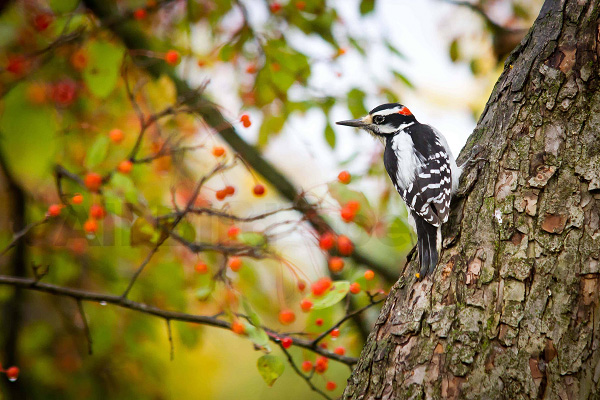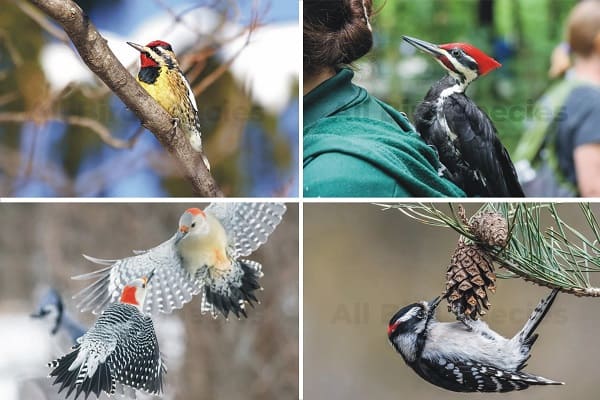9 Types Of Woodpeckers in Alabama With Photos
Key Takeaways:
- Alabama is home to nine species of woodpeckers, each with distinct characteristics and living in specific habitats.
- Some of the best places to spot woodpeckers in Alabama are pine forests and areas with dead trees.
- Woodpeckers have unique behaviors and adaptations, such as using their specialized beaks to drill holes and extract sap.
- Conservation efforts are being made in Alabama to protect endangered woodpecker species, particularly the Red-cockaded Woodpecker.
- Woodpeckers play an important role in maintaining ecosystem balance by controlling insect populations and creating nesting cavities for other bird species.
Types of Woodpeckers in Alabama

Alabama is home to nine distinctive species of woodpeckers, each with its unique features and habitats. Here’s a breakdown of each of the species you can find in the state.
| Species Name | Appearance | Habitat |
|---|---|---|
| Pileated Woodpecker | The largest of all the Alabama
woodpeckers, with a black body, bright red crest, and white stripes on the face |
Found in mature forests,
especially near water sources |
| Red-headed Woodpecker | Distinctive redhead, black and
white wings, and a white stomach |
Found in open habitats,
such as savannas and fields, with scattered trees for nesting |
| Red-bellied Woodpecker | Black and white striped wings,
with a reddish-brown head and back |
Found in urban and suburban
wooded areas, as well as forested areas near waterways |
| Downy Woodpecker | Smallest of the woodpeckers, black
and white feathers, with a distinctive |
Found in open woodlands,
orchards, and forest edges |
| Hairy Woodpecker | Slightly larger than the Downy
Woodpecker, with a longer beak and no red patch on the back of the head |
Found in mature, undisturbed
forests, especially those with large trees |
| Northern Flicker | White underside, black upper
wings, with a red patch on the back of the head and a distinctive black bib |
Found in open woodlands,
orchards, and suburban areas with scattered trees |
| Yellow-bellied Sapsucker | The male has a red throat, black and white
wings, with a yellow stomach, while the females have a white throat |
Found in open wooded areas
near water sources, especially those with birch or maple trees |
| Red-cockaded Woodpecker | Black and white stripes on the back, with a
distinctive red streak on the cheek |
Found in open pine forests,
especially those with longleaf or loblolly pines |
Whether you’re on a hike or birdwatching from your backyard, keep an eye out for these fascinating birds and their unique features!

Where to Spot Woodpeckers in Alabama
Alabama is a wonderful place to spot a variety of woodpecker species. From the elusive Red-cockaded Woodpecker to the common Downy Woodpecker, Alabama is home to many fascinating birds.
The best places to spot woodpeckers in Alabama are pine forests and areas with dead trees. These birds prefer these habitats for their potential nest cavities and abundant food sources. Look for the large, rectangular holes in trees, which are their characteristic marks.

Some of the top locations to find woodpeckers in Alabama include:
Talladega National Forest
The Talladega National Forest is an excellent destination to observe several woodpecker species, including the Red-cockaded Woodpecker, Pileated Woodpecker, and the Hairy Woodpecker. The pine forests here offer ideal foraging grounds and nesting sites.
Wheeler National Wildlife Refuge
The Wheeler National Wildlife Refuge is another great spot to search for woodpeckers. This refuge provides an ideal habitat for the Red-bellied Woodpecker and the Yellow-bellied Sapsucker.
Bankhead National Forest
Bankhead National Forest is a beautiful location to spot the Downy Woodpecker, the Northern Flicker, and the Hairy Woodpecker. These woodpecker species can be found across the forest, particularly in the more wooded locations.
Don’t forget to visit backyard bird feeders to spot these woodpeckers! Place a suitable, sturdy feeder filled with food in an open area that can be seen from inside your home for the best results.
Woodpecker Sounds in Alabama
As I explored the world of woodpeckers in Alabama, I couldn’t help but be enchanted by their unique sounds. These vibrant birds communicate in a variety of ways, from their rhythmic drumming to their calls that sound like laughter.
One of the most distinguishable woodpecker sounds in Alabama is their drumming. This sound is created as a woodpecker taps their beak against a tree or other hard surface up to 20 times per second. Usually, these drums mimic a staccato-like beat and can be heard from a distance of up to a mile away.
Another sound that you may hear when spotting woodpeckers in Alabama is their calls. These calls can vary depending on the species, but you will often hear a series of loud, sharp yelps or a rolling “churr” sound. Many of these calls sound like laughter and are used for a variety of reasons, including territory defense, attracting mates, and communicating with other woodpeckers.
Understanding the different purposes behind these woodpecker sounds is fascinating as it sheds light on their unique communication methods. By appreciating these sounds, you can gain a deeper understanding of Alabama’s woodpecker species and their significance in the state’s ecosystems.

Woodpecker Behaviors and Characteristics
As fascinating birds, woodpeckers have unique behaviors and adaptations that allow them to thrive in Alabama’s diverse ecosystems. Male and female woodpeckers have distinct differences in size and coloration, with males often having brighter feathers and more prominent crests.
Woodpeckers feed on a variety of food sources, including insects, nuts, berries, and fruit. Many species use their strong beaks and special adaptations to access sap from trees, with some even excavating holes for nesting purposes. These special adaptations include barbed tongues that can extend up to four inches, allowing them to access food and sap inside trees.
Woodpeckers build their nests within tree cavities, often taken from previous excavations. They also use these cavities for protection from predators and as roosting sites. Adult woodpeckers take great care in raising their young, often taking turns incubating the eggs and feeding the chicks.
| Behavior/Characteristic | Description |
|---|---|
| Drumming | Woodpeckers use drumming to communicate with each
other and establish territory. They create distinctive beats by rapidly tapping their beaks on trees |
| Drilling | Woodpeckers use their strong beaks and special adaptations
to drill holes in trees for nesting purposes and to extract sap |
| Barbed Tongue | Woodpeckers have long, barbed tongues that can extend
up to four inches, allowing them to extract food and sap from inside trees |
| Nesting | Woodpeckers build their nests within tree cavities,
often taken from previous excavations |
Overall, woodpeckers play an important role in Alabama’s ecosystems, contributing to pest control and providing nesting sites for other bird species. Their unique behaviors and characteristics make them fascinating birds to observe, whether in natural settings or at backyard bird feeders.
Endangered Woodpeckers in Alabama
When it comes to woodpeckers in Alabama, one species is particularly at risk: the Red-cockaded Woodpecker. Due to habitat loss and fragmentation, this endangered species has experienced a dramatic decrease in population over the years.
However, there is hope for their survival. Conservationists have implemented various measures to protect the Red-cockaded Woodpecker’s habitat, including controlled burning and creating artificial cavities for nesting.
Furthermore, partnerships have been formed between private landowners, government agencies, and non-profit organizations to ensure the proper management of the birds’ habitat and population.
“The Red-cockaded Woodpecker is a flagship species for the southeastern longleaf pine forest, with more than 100 other species benefiting from its presence. It’s important to protect and conserve not only the bird itself, but also the ecosystem it depends on.”
Red-cockaded Woodpecker Facts
| Common Name | Red-cockaded Woodpecker |
|---|---|
| Scientific Name | Leuconotopicus borealis |
| Endangered Status | Listed as Endangered under the
Federal Endangered Species Act |
| Population | Less than 5,000 mature individuals |
| Range | Southeastern United States, including Alabama |
| Habitat | Old-growth pine forests, particularly longleaf pine forests |
| Diet | Insects, spiders, and their larvae |
While the Red-cockaded Woodpecker remains a species of concern in Alabama and beyond, efforts are being made to secure a future for these amazing birds. By learning about their habitat requirements and engaging in conservation efforts, we can all contribute to their survival.
Woodpeckers and Their Impact on Ecosystems
As fascinating as they are beautiful, woodpeckers are more than just vibrant birds. Woodpecker species in Alabama create and forage in ways that benefit the surrounding environment, making them an important part of Alabama’s ecosystems.
One way that woodpeckers contribute to their ecosystem is through foraging for insects. Woodpeckers in Alabama are known to consume pests that may otherwise harm trees and forests.
Additionally, woodpeckers create nesting cavities, which can also benefit other bird species that rely on these cavities for shelter. This process helps maintain the balance and health of the forest ecosystems in which they live.
In conclusion, woodpeckers in Alabama play a vital role in maintaining the balance of ecosystems through their unique foraging and nesting behaviors. These vibrant birds are more than just beautiful feathered creatures. They are an integral part of the Alabama environment and worthy of appreciation and protection.
Woodpeckers and Birdwatching in Alabama
Watching woodpeckers in their natural habitat can be a fascinating experience. Alabama is home to several species of woodpeckers, offering numerous opportunities to spot these birds.
The first step to spotting woodpeckers is to identify their habitat. Woodpeckers prefer areas with dead trees, pine forests, and open woodlands. Look for trees with visible damage caused by woodpecker drilling, as this is an indication that the birds are nearby.
If you want to attract woodpeckers to your backyard, consider setting up a bird feeder. Woodpeckers are known to visit backyard feeders that offer suet, peanuts, and sunflower seeds. Just make sure to place the feeder in a visible location that is not too close to your home, as woodpeckers can be noisy.
When birdwatching, it’s important to remain still and quiet to avoid disturbing the birds. Use binoculars or a spotting scope to get a closer look, and listen for their distinct drumming sounds.
Remember to always respect the environment and wildlife. Do not approach the birds or their nesting cavities, and avoid disturbing their habitats in any way. With patience and observation, you can enjoy the beauty of woodpeckers in Alabama.

Interesting Facts About Alabama’s Woodpeckers
Alabama woodpecker species are diverse and fascinating, with interesting behaviors and unique adaptations. Did you know that woodpeckers are the most common birds in Alabama? These vibrant birds can be found in the state all year round, making them a frequent sighting for birdwatchers.
Appearance and Behavior
Alabama is home to nine species of woodpecker, with varying sizes and striking appearances. The Pileated Woodpecker is the largest species in the state, measuring up to 17 inches in length. Woodpeckers have specially adapted feet with two toes pointing forward and two toes pointing backward, allowing them to easily cling to trees while drilling into bark.
Woodpeckers are known for their drumming sounds, which they create by rapidly pecking on trees with their beaks. This behavior serves a variety of purposes, such as attracting a mate or establishing territory. Woodpeckers also use their strong beaks to excavate nest cavities in trees, which they may reuse for several years or pass down to other bird species.
Conservation Efforts
The Red-cockaded Woodpecker is an endangered species in Alabama, with only a few hundred individuals left in the state. Habitat loss and fragmentation are major threats to this species, but conservation efforts are underway to protect their remaining pine savanna habitats.

Fun Facts
| Fact | Description |
|---|---|
| Cranial Adaptations | Woodpeckers have specially adapted skulls
with reinforced bone and a shock-absorbing layer of tissue, allowing them to withstand the force of drilling into trees. |
| Sap Eating | Some woodpeckers in Alabama, such as the Yellow-bellied Sapsucker,
have a unique diet of tree sap, which they extract by drilling shallow holes into trees. |
| High Energy Needs | Woodpeckers have high energy needs due to their constant
drumming and drilling behaviors and can consume up to 20% of their body weight in food per day. |
With their striking appearances and fascinating behaviors, Alabama’s woodpeckers are truly a wonder of nature. Take some time to appreciate these amazing birds and their important role in the state’s ecosystems.
Final Thoughts:
As I conclude this guide on woodpeckers in Alabama, I can’t help but appreciate the beauty and uniqueness of these birds. While we’ve focused on the nine species of woodpeckers found in Alabama, it’s important to remember that these birds are found all over the world.
Woodpeckers are fascinating creatures, with their drumming sounds, tree-clinging abilities, and special adaptations for drilling holes and extracting sap. And in Alabama, they play a critical role in the state’s ecosystems.
By understanding and appreciating woodpeckers in Alabama, we can also help protect them. Whether it’s visiting the best spots to see them in the wild, putting up bird feeders in our backyards, or supporting conservation efforts for endangered species like the Red-cockaded Woodpecker, every small action can make a difference.
So let’s take a moment to marvel at the vibrant woodpeckers in Alabama and beyond, and remember to appreciate and protect these amazing birds for generations to come.
FAQ’s:
Q1: Are there woodpeckers in Alabama?
Alabama is home to many different species of woodpeckers, including the Downy Woodpecker, Hairy Woodpecker, Red-bellied Woodpecker, Red-headed Woodpecker, Pileated Woodpecker, Northern Flicker, Red-cockaded Woodpecker, and the Yellow-bellied Sapsucker.
Q2: What is the most common woodpecker in the US?
The most common woodpecker in North America is the Downy Woodpecker (Picoides pubescens.
Q3: What’s the biggest woodpecker?
The Imperial woodpecker (Campephilus imperialis) is the largest in the world. It can grow up to 23.6 inches in length and has a wingspan of 30 inches.
Q4: Where are most woodpeckers?
Woodpeckers are found worldwide, except in the regions of Australia and New Guinea. They are most abundant in South America and Southeast Asia.
Q5: What is Alabama’s state bird?
The Northern Flicker (Colaptes auratus) is the state bird of Alabama. It was adopted as the state bird in 1927 and is also known as the Yellowhammer.







